Penn State Program Brings Low-Cost Medical Care to Africa
August 13, 2009

"The word ‘Mashavu' means ‘chubby cheeked' in Swahili, andthat's what we want all the children in East Africa to look like," said Khanjan Mehta, senior researchassociate in the School of Engineering at Penn State University explaining therationale behind the name of an innovative program that is bringing networkedhealth solutions to the developing world. Mehta was speaking at Thursday's keynote session atNIWeek, during which several student teams were describing their use of LabVIEW, a graphical programmingenvironment for developing measurement, test, and control systems.
The explicit goal of the Mashavuprogram, which involves more than 100 students and 6 faculty members across8 colleges at Penn State, is to connect people in East Africa to physicians and improve their access to healthcare. Thereis only one doctor for every 50,000 people here, as compared to every 390people in the US.
Though doctors are not in abundance in this region of theworld, cell phones are, explained Metha. "Some 97% of the people in East Africa have access to cell phones, and PCs aregetting into more and more places. We realized that there was an opportunity toleverage the network to connect the rural community to doctors."
One of the primary engineering goals of the Mashavu programis to develop affordable medical devices that can operate under oftentimesrugged and harsh conditions. According to Mehta, even $60 for a device tomeasure a patient's lung capacity is too costly in a region of the world wherethe mean income is less than $1 per day.
Leveraging virtual instrumentation, students who take a Bioengineering Junior Design class taught by Peter Butler are redesigning a range of devices,including a spirometer and a pulse rate monitor. "One of the main goals is to minimizethe hardware and move as much as possible into the software on the computer,"says Mehta. "So Mashavu's biomedicaldevices consist of a sensor and the minimal hardware around it. The signalconditioning and display are in the LabVIEWprogram on the computer."
Biomedical Engineering Student Brittany Flaherty demonstrated a proof-of-concept,$10 pulse rate monitor developed through the Mashavu program by taking thepulse of Ray Almgren, vice president of academic marketing at NI, during thekeynote. (It was 90 bpm.) Simple indesign, it consists of a sensor attached to cardboard, a Velcro strap, and aUSB port. Flaherty described how LabVIEWsoftware is used to take the sensor outputs and compute a pulse. Theinformation is then uploaded to a server, where a doctor anywhere would be ableto access the information.
Teams are currently testing the devices in the field, havingjust returned from three weeks in East Africa.With a fully functional proof-of-concept in hand and testing underway, theemphasis is now shifting to commercialization efforts. Penn State'splan is to put as much of the IP out there as possible and find a partner whowill commercialize the product.
As for the engineering students, Mehta says that the programoffers them an amazing opportunity to get real-world design experience and seefirst-hand the impact of their work. "People were excited about thetechnology," says Flaherty. "We met some seniors who had never had their bloodpressure taken or their weight measured in their life."
NI's website features a detailed article on the Mashavu stethoscope project.
Penn State Program Brings Low-Cost Medical Devices to Africa
About the Author(s)
You May Also Like






